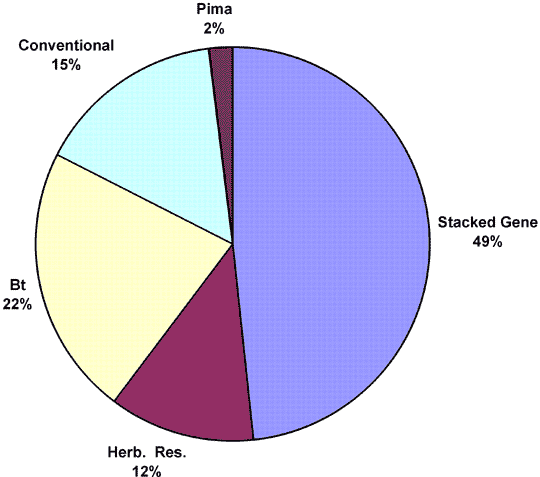Review of the 2001 Arizona Cotton Season
by Jeffrey C. Silvertooth,
Extension Agronomist, Professor & Head, SWES
According to the Arizona Agricultural Statistics Service (USDA), a total of 285,500 acres were planted to cotton in 2001. Approximately 278,000 acres consisted of Upland (Gossypium hirsutum L.) varieties and 7,500 acres were planted to American Pima (G. barbadense L.) cotton. Current yield estimates indicate a statewide average of 1,253 lbs. lint/acre for Upland and 960 lbs. lint/acre for Pima. Arizona crop production estimates project a total of 730,000 bales for Upland and 15,000 bales for Pima cotton in 2001. For both Upland and Pima these are "average" yields for Arizona. For example, the 2001 average yield estimates for Upland cotton are very close to the five-year average (~1250 lbs. lint/acre). However, the 2001 Upland cotton yields will be lower than yields experienced in 2000 (1312 lbs. lint/acre), which happened to be one of the best years (in terms of lint yield) in the past decade.
Arizona continues to plant a rather large proportion of the acreage to transgenic varieties. Seed sales estimates (Figure 1) indicate that transgenic varieties were planted on approximately 83% of the Arizona acreage in 2001. The Bt and herbicide resistant (Roundup Ready (RR) and Buctil resistant) varieties have been very important in Arizona in recent years. In 2001, the acreage planted to the "stacked gene" varieties that possess both Bt and RR characteristics, increased once again. This is a trend that has become consistent in Arizona in recent years.
Overall, the growing season progressed rather well for most cotton producing areas in Arizona in 2001. The greatest difficulties were experienced in the early stages of the season, particularly in western Arizona (the lower Colorado River Valley) where cold and wet weather conditions hampered planting and stand establishment through February and early March. These difficulties also extended into some parts of central Arizona and in some cases resulted in poor stand populations and early season plant vigor. Many early planted fields in this part of the state required replanting. Beyond mid-March, planting conditions improved considerably and many areas in central and eastern Arizona experienced excellent early season stands and crop development.
Weather conditions were generally favorable during the primary growing season (April through September). There were some areas in western and central Arizona where fruit retention levels were substantially reduced due to heat stress. This reduced fruit retention was due to short periods of very hot weather (e.g. early July) that coincided with vulnerable stages of crop growth (early to mid fruiting cycle). However, the resulting poor fruit retention was more of a local phenomenon in few areas and did not constitute a statewide problem. In general, crop growth and development proceeded in a "normal" pattern with respect to heat unit accumulations and calendar dates in most areas. The harvest season was hot and dry, which helped accelerate the progress of picking and crop completion. Generally, Arizona harvested a very early crop in 2001. This was due to the early irrigation terminations imposed on many fields this season and the rapid progression of final crop development and defoliation.
High micronaire values have plagued the Arizona Upland cotton crops in recent years. One bright spot for the 2001 crop is that only 28% of the Upland cotton has been classified as having fiber micronaire in the discount range (>= 5.0). This represents a substantial reduction in relation to recent years for Arizona. However, the high micronaire problem still exists and continues to be a point of major concern for future Arizona cotton production.
Figure 1. Percentages of cotton types grown in Arizona in 2001. (Source: based on seed sales in Arizona) Note: Herb. Res. = Herbicide Resistant (RR and Buctril Resistant varieties)
Issued in furtherance of Cooperative Extension work, acts of May 8 and June 30, 1914, in cooperation with the U.S. Department of Agriculture, James A. Christenson, Director Cooperative Extension, College of Agriculture and Life Sciences, The University of Arizona.
The University of Arizona is an equal opportunity, affirmative action institution. The University does not discriminate on the basis of race, color, religion, sex, national origin, age, disability, veteran status, or sexual orientation in its programs and activities.
Any products, services, or organizations that are
mentioned, shown, or indirectly implied in this web document do not imply
endorsement by The University of Arizona.
Information provided by Jeffrey C. Silvertooth, silver@ag.arizona.edu
Extension Agronomist, Professor & Head, SWES, College of Agriculture and Life Sciences, The University of Arizona.
Material written December 15, 2001.
Crop Mgmt | Soil Mgmt | Irrigation | Varieties | Cotton Comments
Home | Cotton | Advisories
document located at: http://cals.arizona.edu/crops/cotton/comments/dec2001cc.html
Copyright © 2001 University of Arizona,
College of Agriculture and Life Sciences
Webmaster: Al Fournier (acis@ag.arizona.edu)
